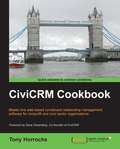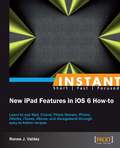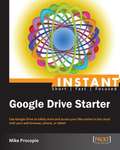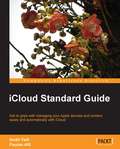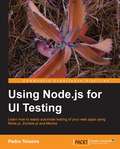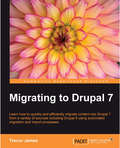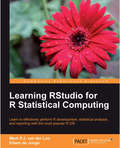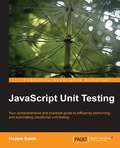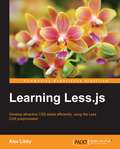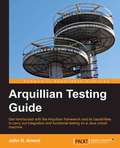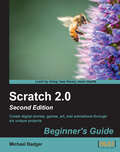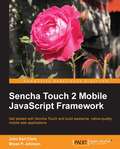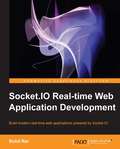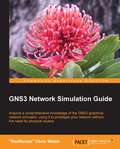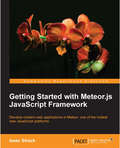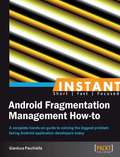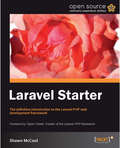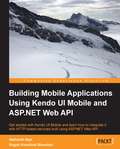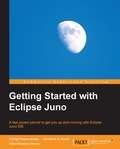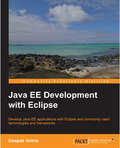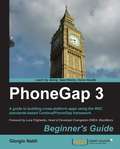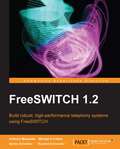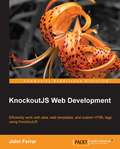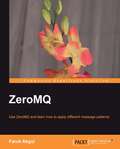- Table View
- List View
CiviCRM Cookbook
by Tony HorrocksThis book is written in cookbook style with practical, comprehensive recipes expained with the aid of the necessary screenshots.If you have basic CiviCRM skills and want to further enhance your CiviCRM skills, this book is for you.
Instant New iPad Features in iOS 6 How-to
by Renee J. ValdezA how-To book with practical recipes accompanied with rich screenshots for easy comprehension. "The New iPad: Using New Features in iOS 6 How-To" is for anyone somewhat familiar with an iPad but wanting to get an overview of its new features. A basic understanding of touch devices is good but not necessary. The recipes walk you through everything you need to know to accomplish each task. Good for the novice and the expert, there's something in here for everyone.
Instant Google Drive Starter
by Mike ProcopioThis book is a Starter which teaches you how to use Google Drive practically. This book is perfect for people of all skill levels who want to enjoy the benefits of using Google Drive to safely store their files online and in the cloud. It's also great for anyone looking to learn more about cloud computing in general. Readers are expected to have an Internet connection and basic knowledge of using the internet.
iCloud Standard Guide
by Andri Yadi Fauzan AlfiAn easy-to-use guide, filled with tutorials that will teach you how to set up and use iCloud, and profit from all of its marvellous features.This book is for anyone with basic knowledge of computers and mobile operations. Prior knowledge of cloud computing or iCloud is not expected.
Using Node.js for UI Testing
by Pedro TeixeiraFull of techniques and tips for simulating user interactions and verifying that your application is behaving correctly.This book is for frontend and backend web application developers that know how to program in JavaScript.
Migrating to Drupal
by Trevor JamesWritten in a friendly and engaging style with practical tutorials and step-by-step examples which show you how to easily migrate your Drupal 6 or WordPress site to Drupal 7. "Drupal 7: A Guide to Migration" is for anyone interested in how to move content from an existing website into the Drupal content management system. Both novice and advanced Drupal users will gain practical hands-on knowledge in how to migrate content into Drupal using this book. You will become experts in using the Feeds module to migrate content, and in packaging your code using Features.
Learning RStudio for R Statistical Computing
by Edwin De Jonge Mark Van LooA practical tutorial covering how to leverage RStudio functionality to effectively perform R Development, analysis, and reporting with RStudio. The book is aimed at R developers and analysts who wish to do R statistical development while taking advantage of RStudio functionality to ease their development efforts. Familiarity with R is assumed. Those who want to get started with R development using RStudio will also find the book useful. Even if you already use R but want to create reproducible statistical analysis projects or extend R with self-written packages, this book shows how to quickly achieve this using RStudio.
JavaScript Unit Testing
by Hazem SalehA practical, example-driven guide to using, automating, and integrating JavaScript Unit tests for the busy and conscientious JavaScript developer striving for excellence and success. JavaScript Unit Testing is a must have guide for every web developer, designer, architect, and JavaScript coder seeking to ensure the highest quality of their web applications and JS code. Knowledge of JavaScript is assumed.
Canvas LMS Course Design
by Ryan JohnThis book is intended for educators who want to use Canvas to enhance their teaching or for educators whose institution has adopted Canvas as its learning management system. Whether you are brand new to online learning or you are a seasoned expert, you will be able to master both the basic functions and the advanced features of Canvas with this book.
Learning Less.js
by Alex LibbyIf you are a designer or developer who wants to quickly learn how to harness the power of Less.js to write more efficient CSS styles that can be applied to a website of any size, then this book is for you. This book will help you master both the basic functions and advanced features of Less.js. It would be helpful to have some familiarity of writing CSS styles, although no prior experience of using CSS preprocessors is required.
Arquillian Testing Guide
by John D. AmentThis book is a tutorial filled with plenty of code examples and strategies to give you many options when building your test structure.This book is for developers and testers alike. Anyone who has worked with test driven development or building automated test cases will find use in this book. A reader should be familiar with some automation strategies and techniques such as JUnit and should have some exposure to techniques such as mocking.
Scratch 2.0 Beginner's Guide Second Edition
by Michael BadgerThe book uses step-by-step instructions along with full code listings for each exercise. After each exercise, the author pauses to reflect, explain, and offer insights before building on the project. The author approaches the content with the belief that we are all teachers and that you are reading this book not only because you want to learn, but because you want to share your knowledge with others. Motivated students can pick up this book and teach themselves how to program because the book takes a simple, strategic, and structured approach to learning Scratch. Parents can grasp the fundamentals so that they can guide their children through introductory Scratch programming exercises. It's perfect for homeschool families. Teachers of all disciplines from computer science to English can quickly get up to speed with Scratch and adapt the projects for use in the classroom.
Sencha Touch 2 Mobile JavaScript Framework
by Bryan P. Johnson John Earl ClarkFull of explained code and enriched with screenshots, this book is the practical way to take your Sencha Touch skills to the next level.If you want to gain practical knowledge for using the Sencha Touch mobile web application framework, and you are familiar with HTML and CSS, then this book is for you. It is assumed that you know how to use touchscreens, touch events, and mobile devices such as Apple iOS and Google Android.
Socket.io Real-time Web Application Development
by Rohit RaiWritten in an engaging, easy-to-follow style, "Socket.io Real-time Web Application Development" is a practical guide for developing real-time web applications with Node.js and socket.io.This book is aimed at developers who want to start developing highly interactive and real-time web applications like chat systems or online multiplayer games, or want to introduce real-time updates or server push mechanisms in their existing applications. Knowledge of developing in JavaScript and web applications in general is expected. Though there is a chapter on introducing Node.js, prior knowledge of Node.js will be a plus.
GNS3 Network Simulation Guide
by Rednectar" Chris WelshGNS3 Network Simulation Guide is an easy-to-follow yet comprehensive guide which is written in a tutorial format helping you grasp all the things you need for accomplishing your certification or simulation goal. If you are a networking professional who wants to learn how to simulate networks using GNS3, this book is ideal for you. The introductory examples within the book only require minimal networking knowledge, but as the book progresses onto more advanced topics, users will require knowledge of TCP/IP and routing.
Getting Started with Meteor.js JavaScript Framework
by Isaac StrackWritten in an engaging, easy-to-follow style, "Getting Started with Meteor" is a practical guide for developing modern web applications with Meteor. This book is for developers or students who have a working knowledge of JavaScript and HTML, and want to learn how to quickly develop web applications using pure JavaScript. A basic understanding of traditional web server development and database methodologies will be helpful, but not necessary. Readers are expected to know how to program basic HTML pages and JavaScript functions, and be familiar with Terminal (basic Shell) commands.
Instant Android Fragmentation Management How-to
by Gianluca PacchiellaWritten in the easy to understand Packt How-to format, this book offers the solution to the big issues in Android application development. If you want the best possible reviews for your apps, regardless of device or Android operating system, then this book is for you.
Laravel Starter
by Shawn MccoolThis book is a practical, task-based, step-by-step tutorial that demonstrates topics ranging from MVC code-separation, to code-modularity, to utilizing ActiveRecord for data abstraction which are explained from the ground-up to provide a strong framework of understanding for creating professional web-applications with Laravel. This book is ideal for programmers familiar with PHP who are interested in learning the Laravel way of solving the common problems faced in their day to day work.
Building Mobile Applications Using Kendo UI Mobile and ASP.NET Web API
by Nishanth Nair Ragini Kumbhat BhandariWith easy-to-follow, step-by-step and real-life examples, you will be building your own mobile applications in a matter of days using Kendo Mobile UI and ASP.NET Web API. If you are a web applications developer new to mobile applications development, then this book is for you. You will also benefit from this book if you have experience in mobile applications development and would like to explore the Kendo UI. A basic understanding of HTML, CSS, and jQuery is desirable to follow this book.
Getting Started with Eclipse Juno
by Rodrigo Fraxino Araujo Vinicius H. Durelli Rafael Medeiros TeixeiraWritten as a concise yet practical guide that details the main features which are usually required by a programmer who makes use of the Eclipse platform, this book covers Eclipse 3.8 in a way that is accessible to the Java novice and expert alike. The reader is guided through a series of hands-on examples that introduce Eclipse and some of its plugins.The primary audience for this book are the Java programmers. This book has been written in a way that it is accessible both to beginners and advanced Java programmers alike. Also, if you are a seasoned Java developer who has been using another IDE and wondering what Eclipse brings to the table, this book will provide you with a hands-on walkthrough of the main IDE features. This book will also be beneficial to any computer science undergraduate or a graduate student who are familiar with Java.
Java EE Development with Eclipse
by Deepak VohraThis book is step-by-step tutorial guide and a background reference for developing applications with Oracle WebLogic Server and Oracle database, the most used application server and database for enterprise applications. This book is for professional Java EE developers. The book is also suitable for an intermediate/advanced course in Java development with Eclipse IDE. Some knowledge of the Java EE technologies and frameworks EJB, JSF, JAXB, JAX-WS, JAX-RS, Ajax, and Spring is required.
PhoneGap 3 Beginner's Guide
by Giorgio NatiliWritten in a friendly, example-driven Beginner's Guide format, there are plenty of step-by-step instructions to help you get started with PhoneGap.If you are a web developer or mobile application developer interested in an examples-based approach to learning mobile application development basics with PhoneGap, then this book is for you.
FreeSWITCH 1.2
by Raymond Chandler Michael S Collins Darren Schreiber Anthony MinessaleThis book is full of practical code examples aimed at a beginner to ease his or her learning curve.This book is written for IT professionals and enthusiasts who are interested in quickly getting a powerful telephony system up and running using the free and open source application, FreeSWITCH.Telephony experience will be helpful, but not required.
KnockoutJS Web Development
by John FarrarThis book is for web developers and designers who work with HTML and JavaScript to help them manage data and interactivity with data using KnockoutJS. Knowledge about jQuery will be useful but is not necessary.
ZeroMQ
by Faruk AkgulA practical, step-by-step example-rich tutorial.If you are a C developer who wants to learn about ZeroMQ, this book is for you. It is assumed that the reader has C experience at some level but prior ZeroMQ knowledge is not expected.
